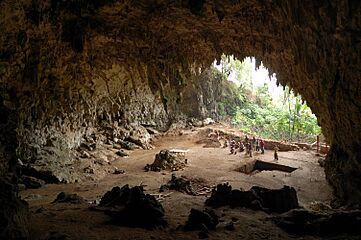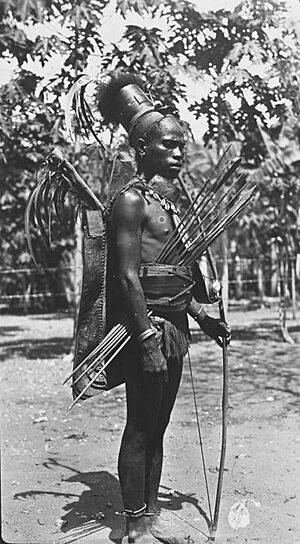Flores facts for kids

Topography of Flores
|
|

Location of Flores
|
|
| Geography | |
|---|---|
| Location | Southeast Asia |
| Coordinates | 8°40′29″S 121°23′04″E / 8.67472°S 121.38444°E |
| Archipelago | Lesser Sunda Islands |
| Area | 14,731.67 km2 (5,687.93 sq mi) |
| Area rank | 60th |
| Length | 354 km (220 mi) |
| Width | 66 km (41 mi) |
| Highest elevation | 2,370 m (7,780 ft) |
| Highest point | Poco Mandasawu |
| Administration | |
|
Indonesia
|
|
| Province | East Nusa Tenggara |
| Largest settlement | Maumere (pop. 91,550) |
| Demographics | |
| Population | 1,962,405 |
| Pop. density | 133.2 /km2 (345 /sq mi) |
Flores is a beautiful island in the eastern part of Indonesia. It's one of the Lesser Sunda Islands. This island is the largest in the East Nusa Tenggara Province.
Flores covers about 14,731 square kilometers (5,688 square miles). In mid-2023, nearly 2 million people lived there. The biggest towns on Flores are Maumere and Ende. The name Flores comes from the Portuguese word for "Flowers".
The island is located east of Sumbawa and the Komodo Islands. To its west are the Solor Islands and the Alor Archipelago. Timor is to the southeast. Across the Sumba Strait to the south is Sumba Island. To the north, across the Flores Sea, is Sulawesi.
Flores is the 10th most populated island in Indonesia. It's also the 10th largest island in the country. Before modern humans arrived, a small, ancient human species called Homo floresiensis lived here.
Contents
What Does the Name Flores Mean?
Unlike many Indonesian islands, the name Flores was given by the Portuguese. The word Flores means "Flowers" in Portuguese.
Some local stories from the Sika region say the island's original name was Nusa Nipa. This means "Dragon island" or "Snake island". The eastern part of the island was first called Kopondai. It was later named Cabo das Flores, or "Cape of Flowers". This was because of the many flowering flamboyant trees found there. That name stuck!
Flores Island History
Ancient History and Homo floresiensis
Before modern humans, Flores was home to Homo floresiensis. These were small, ancient humans. Their ancestors arrived on the island between 1.3 and 1 million years ago.
Scientists have found parts of fifteen Homo floresiensis individuals. Most experts agree they are a unique human species. They have different body features from modern humans. The latest findings suggest Homo floresiensis died out about 50,000 years ago. This was around the time modern humans came to the area.
Modern History and European Influence
Flores was likely first settled by Melanesians around 30,000 BC.
Portuguese traders and missionaries came to Flores in the 1500s. They mainly settled in Larantuka and Sikka. Their influence can still be seen in the language, culture, and religion of Sikka today. The first Portuguese visit was in 1511.
The Dominican order (a group of Catholic priests) was very important on Flores. They also had a big role on the nearby islands of Timor and Solor. When the Dutch attacked a fort on Solor in 1613, the people moved to Larantuka. This group was a mix of Portuguese and local islanders. They were known as Larantuqueiros or Topasses. The Dutch called them the 'Black Portuguese'.
These Larantuqueiros became powerful traders of sandalwood for 200 years. An English explorer, William Dampier, visited Flores in 1699. He noted that these people spoke Portuguese and were Roman Catholic. They said they were loyal to the King of Portugal. But they would not accept officers sent by him.
In western Flores, the Manggarai were controlled by the Sultanate of Bima. This was a kingdom in eastern Sumbawa. The Dutch took control of western Flores in 1907.
In 1854, Portugal gave up all its claims on Flores. After this, Flores became part of the Dutch East Indies.
World War II and Independence
During World War II, Japan occupied Flores. This happened on May 14, 1942. Japanese forces landed at Labuan Bajo and Reo. Japan stayed on Flores until the end of the war.
After the war, Flores became part of independent Indonesia.
On December 12, 1992, a strong earthquake hit Flores. It measured 7.8 on the Richter scale. About 2,500 people died in and around Maumere.
How Flores is Governed
Flores is part of the East Nusa Tenggara province. The island is divided into eight local government areas called regencies. From west to east, these are Manggarai Barat (West Manggarai), Manggarai (Central Manggarai), Manggarai Timur (East Manggarai), Ngada, Nagekeo, Ende, Sikka and part of Flores Timur (East Flores).
Flores has about 35% of the population of East Nusa Tenggara province. It is the largest island in the province.
The main towns on Flores are:
- Maumere, with about 91,550 people.
- Ende, with about 88,921 people.
- Ruteng, with about 43,578 people.
- Larantuka, with about 41,500 people.
- Bajawa, with about 40,259 people.
Flores Island Animals and Plants
The famous Komodo dragon lives only on Flores and nearby islands. It has been on Flores for at least 1.4 million years. Today, you can find them in only a few small areas on Flores.
Flores is also home to unique rats. Some are now extinct. These rats ranged from small to giant, like the Papagomys armandvillei (Flores giant rat). This rat is about the size of a rabbit and can weigh up to 2.5 kilograms (5.5 pounds).
In the past, Flores also had dwarf elephants called Stegodon. The last ones disappeared about 50,000 years ago. Giant storks and vultures also lived here before modern humans arrived.
Earthquakes on Flores Island
Flores Island is in an active earthquake zone. The Sunda Trench is to the south, and the Flores Back Arc Thrust Fault is to the north. Because of this, the island has many earthquakes each year. Sometimes, it also experiences tsunamis (giant ocean waves).
The biggest earthquake recorded in the area was in 1992. It was a magnitude 7.8 event. This earthquake caused severe shaking and a tsunami.
Flores Island Culture
Languages of Flores
Many languages are spoken on Flores Island. All of them belong to the Austronesian family. In the west, people speak Manggarai. In the center, there is a group of languages called the Central Flores dialect chain. This means that almost every village has slightly different ways of speaking.
At least six separate languages are found here. These include Ngadha, Nage, Keo, Ende, Lio, and Palu'e. The Palu'e language is spoken on a small island off the north coast of Flores. To the east, you'll find Sika and Lamaholot.
Social Life
Traditional social life on Flores is based on large family groups. These family ties create a clear social order within villages. This is similar to the social structure on Lembata island. You can see this in the unique spiderweb-shaped rice fields around Cancar.
Religion on Flores
Religion in Flores (2023) Roman Catholic (83.56%) Protestantism (1.17%) Islam (15.21%) Hinduism (0.05%) Buddhism (0.01%) Others (0.00%)
Most people on Flores are Roman Catholic Christians. This is different from most other Indonesians, who are Muslim. Catholicism became strong on the island because of Portuguese rule in the east. Later, the Dutch also supported it in the west.
Flores has less religious conflict than some other parts of Indonesia. This is because the religious groups are more separated. There are many churches on the island. In 2019, the first Catholic University in Flores opened. Besides Catholicism, Islam is also present, especially in some towns along the coast.
Totemism and Nature
Totemism is still practiced on Flores. This means people link themselves to plants and animals in special ways. Many family groups (called woe) on Flores are named after trees. These trees then become sacred or "taboo" (pie). This means they cannot be burned or used as fuel. For example, the Nage people are named after the tamarind tree.
Some groups are not named after plants but still have taboo trees. The Nage people have plant totems but no animal totems. This means they can kill and eat any animal. However, their neighbors, the Ngadha people, have animal taboos as well as plant taboos.
Textiles and Weaving
Weaving is an important tradition on Flores. People use cotton grown in the lower areas of the island. Each ethnic group on Flores has its own way of dyeing, weaving, and trading textiles.
Dyes Used in Textiles
The main dyes used are indigo (for blue), turmeric (for yellow), and morinda (for red).
- Blue (indigo): Indigo plants grow in the middle elevations. It's the most common plant for blue and black dyes.
- Red (morinda and others): Morinda citrifolia is used for red dye in some areas. Other plants are also used for red.
- Yellow (turmeric, mango, and others): Yellow is called kuma. Turmeric is used for yellow. Mango bark and other plants are also used to create different shades of yellow.
- Green color: Green is rare in textiles from some parts of Flores. It's mostly made by mixing blue and yellow dyes. In the Lamalera region, green juice from plants like Annona squamosa is used.
Textile Styles of Different Areas
- Ngadha Region: In the Ngadha region, everyday clothes are plain indigo sarongs. But there's also a special type of ikat (a dyed fabric) called Bajawa ikat. It has simple designs and uses only indigo dye. The blue color is very deep because the cloth is soaked many times. The patterns are often of horses (jara). Horses show high social rank. These patterns look like ancient cave drawings, making them very unique.
Things to See and Do in Flores
The most famous place to visit in Flores is the Kelimutu volcano. It's 1,639 meters (5,377 feet) high. It has three amazing colored lakes inside its caldera. These lakes change colors often, from bright red to green and blue. This happens because of volcanic gases.
You can also go snorkeling and diving along the north coast. Popular spots include Maumere and Riung.
Labuan Bajo, on the western tip, is a popular starting point for tourists. From here, you can visit Komodo and Rinca islands. These islands are home to the Komodo dragons. Labuan Bajo is also great for scuba diving. You might even see whale sharks there!
The Luba and Bena villages show traditional Flores houses. Bena is also famous for its ancient Stone Age megaliths.
Larantuka, on the eastern side of the island, is known for its Holy Week festivals. These are special religious celebrations.
Some companies offer cycling tours around Flores. These tours can last five or six days.
Flores Island Economy
Besides tourism, the main ways people make a living on Flores are farming, fishing, and growing seaweed. The main food crops are rice, maize (corn), sweet potato, and cassava. For money, people grow coffee, coconut, candle nut, and cashew. Flores coffee is becoming well-known for its rich taste.
In the 1980s, growing cotton was encouraged to help farmers earn more money. Cotton is planted in the lower areas of the island.
Jackfruit is also grown on Flores, especially in Manggarai and Sikka regencies.
Images for kids
-
An ancient Ngada megalith
Transport
Flores has at least six airports across the island:
- Komodo Airport in Labuan Bajo
- Frans Sales Lega Airport or Ruteng airport
- Pahdamaleda Airport or Bajawa airport
- Turelelo Soa Airport in Bajawa
- H. Hasan Aroeboesman Airport or Ende airport
- Frans Xavier Seda Airport or Maumere airport
- Gewayantana Airport close to Larantuka city.
See also
 In Spanish: Isla de Flores (Indonesia) para niños
In Spanish: Isla de Flores (Indonesia) para niños














